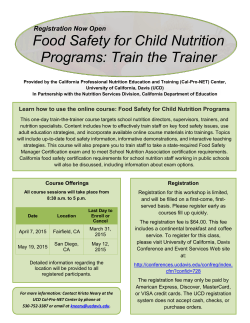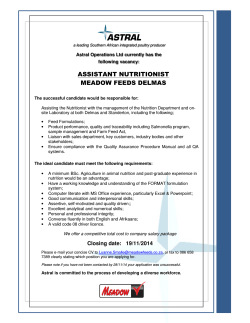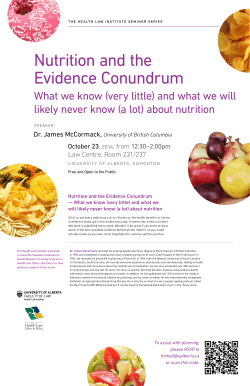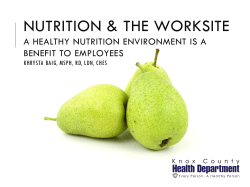
CD - Dallas Colleges Online - Dallas County Community College
NCPACE BIOL 1322 Syllabus Nutrition Pathways Course Description This is an introduction to human nutrition. Topics will include classes, sources, and function of nutrients; digestion and absorption; and metabolism with application to normal and therapeutic nutritional needs. Textbook: Whitney, Eleanor Noss, and Sharon Rady Rolfes. Understanding Nutrition. 12th ed. Belmont, Calif.: Wadsworth 2011. ISBN (10): 0-538-73465-5; ISBN (13): 978-0-538-73465-3 Student Course Guide: Maness, Marie Yost. Student Course Guide for Nutrition Pathways: Introduction to Nutrition. 7thed. Belmont, Calif.: Wadsworth, 2010. ISBN (10): 0-538-73964-9; ISBN (13): 9780-538-73964-1 Video Lessons: Four CD-ROMs that contain the video programs from video series, Nutrition Pathways Table of Contents Welcome to Nutrition Pathways !.......................................................................................3 Course Outcome...........................................................................................................................4 Intellectual Competency ..............................................................................................................4 Exemplary Educational Objectives / Student Learning Outcomes ..............................................4 Course Requirements ...................................................................................................................4 Course Format ..............................................................................................................................5 Study Tips ....................................................................................................................................5 Academic Integrity.......................................................................................................................5 Assignment Calendar ...................................................................................................................6 Assignment Information ..............................................................................................................10 Course Evaluation ........................................................................................................................10 NCPACE BIOL 1322 2012–2013 2 BIOL 1322 Syllabus Nutrition Pathways Welcome to Nutrition Pathways! Nutrition Pathways is a survey course of basic concepts. Each lesson covered could easily be a course in itself. Many of you may be majoring in nutrition or other allied health programs that have an introduction to nutrition degree requirements; others may be non-majors who are interested in learning about basic nutrition as it applies to their own lives and the lives of their families. The text presents the nutrition concepts; the video programs personalize the concepts from the text in practical ways; and the student course guide serves as your daily instructor by providing specific guidance on what to study in the text and videos. Depending on your needs and degree requirements, the amount of nutrition information you want to master is up to you. Although this course covers the required nutrition concepts associated with a collegelevel introductory nutrition course, it is also designed to engage you in the lives of the individuals who are profiled in the video lessons. You will experience many of the same day-today challenges as the video subjects who make nutrition and lifestyle choices that impact their health and well-being. The Dallas TeleCollege Online hopes this course will ultimately help you modify your own nutrition and lifestyle habits in order to lead more successful lives. Important: Keep this syllabus handy and use it as a guide throughout the semester. Sincerely, Dallas TeleCollege Online Military Support Team NAVY@dcccd.edu 888-468-4268 http://military.dcccd.edu NCPACE BIOL 1322 2012–2013 3 Course Outcome Course Outcome The BIOL 1322 course outcome is to help students apply basic scientific nutrition principles as well as practical nutrition information to personal life and/or therapeutic situations in order to enhance health, wellness, and longevity. Students will engage in a variety of activities/assessments in order to demonstrate learning of the course outcome. Intellectual Competency As defined by The Texas Higher Education Coordinating Board, the Intellectual Competency of Critical Thinking embraces methods of applying both qualitative and quantitative skills analytically and creatively to subject matter in order to evaluate arguments and to construct alternative strategies. Problem solving is one of the applications of critical thinking, used to address an identified task. Exemplary Educational Objectives / Student Learning Outcomes Students who successfully complete the Principles of Nutrition course should be able to: 1. Identify and differentiate between the classes of nutrients as they relate to basic chemistry, function, food sources, and the life-cycle from pregnancy through aging. 2. Identify and analyze basic steps and potential problems involved in ingestion, digestion, absorption, and transport of nutrients. 3. Compare and contrast the steps in energy metabolism for the energy-yielding nutrients. 4. Differentiate between chronic diseases as they relate to nutrition and lifestyle factors. 5. Analyze, design, and implement a personal nutrition and exercise plan to enhance personal wellness that can lead to a healthier, more productive life. Course Requirements To complete this course successfully, you should do the following: 1. Complete the assigned related activities in the student course guide. 2. View the thirty-minute video lessons. Make sure all the downloaded files are working properly PRIOR to deployment. 3. Complete four examinations. 4. Prepare and submit all assigned course papers. NCPACE BIOL 1322 2012–2013 4 Course Format Course Format In addition to your instructor, the learning system in Nutrition Pathways includes: 1. The student course guide 2. The textbook 3. The video programs Study Tips The following study sequence will maximize your chances for successfully completing each lesson in this course: 1. Read the Lesson Overview in the student course guide. 2. Read over the Learning Objectives and Text Focus Points, then read the assigned material in the Whitney and Rolfes textbook as referenced in your student course guide. 3. Review the Video Focus Points, then watch the video program and take notes as needed (i.e., connected to video objectives). Academic Integrity The purpose of the Code of Student Conduct and Hazing is to provide guidelines for the educational environment of the Dallas County Community College District. Such an environment presupposes both rights and responsibilities. Disciplinary regulations at the college are set forth in writing in order to give students general notice of prohibited conduct. Students should be aware of disciplinary actions for all forms of academic dishonesty, including cheating, fabrication, facilitating academic dishonesty, plagiarism, and collusion. NCPACE BIOL 1322 2012–2013 5 Assignment Calendar Weeks 1 Topics Covered Workbook Lesson 1: Nutrition Basics Textbook Chapter 1: An Overview of Nutrition Chapter 2: Planning a Healthy Diet Videos Nutrition Basics View Lessons Workbook 2 3 Student Activities Complete related activity (20 pts): Calculating the Energy Found in Foods, p. 5 Read: Chapter 1: pp. 3–33 Chapter 2: pp. 35–67 2: The Digestive System 3: Carbohydrates: Simple and Complex 4: Carbohydrates: Fiber Complete related activity (20 pts): Learning about Fiber in Foods. p. 49 Textbook Chapter 3: Digestion, Absorption, & Transport Chapter 4: The Carbohydrates: Sugars, Starches, & Fibers Read: Chapter 3: pp. 69–95 Chapter 4: pp. 97–131 Videos From video series, Nutrition Pathways The Digestive System Carbohydrates: Simple and Complex Carbohydrates: Fiber View Workbook Lessons: 5: Fats: The Lipid Family 6: Fats: Health Effects Complete related activity (20 pts): Determining Percentage of Calories and Fat Grams from Fat Intakes, p. 73 Textbook Chapter 5: The Lipids: Triglycerides, Phospholipids, and Sterols Read pp. 133–171 Videos From video series, Nutrition Pathways Fats: The Lipid Family Fats: Health Effects View EXAM #1 NCPACE BIOL 1322 Covers Lessons 1 – 6 2012–2013 Schedule Exam with ESO Proctor 6 Assignment Calendar For ease the explanation: Workbook: Student Course Guide for Nutrition Pathways: Introduction to Nutrition Textbook: Understanding Nutrition Video series: Nutrition Pathways Weeks Topics Covered Student Activities Complete the following related activities (20 pts each): Calculating Personal RDA for Protein. p. 95 Metabolism, pp. 109–115. Answers are provided, an easy 20 points. Workbook Lessons: 7: Protein: Form and Function 8: The Protein Continuum 9: Metabolism Textbook Read: Chapter 6: Protein: Amino Acids Chapter 6: pp. 173–196 Chapter 7: Metabolism: Transformations Chapter 7: pp. 205–239 and Interactions Appendix D Videos From video series, Nutrition Pathways Protein Form and Function The Protein Continuum Metabolism View Lessons: 10: Weight Control: Energy Regulation 11: Weight Control: Health Effects Complete the following related activities (20 pts each) Estimating Personal Energy Expenditure, p. 125 Calculating Personal Body Mass Index, p. 127 Assessing Body Weight & Fat Distribution, p. 129 Chapter 8: Energy Balance and Body Composition Chapter 9: Weight Management: Overweight, Obesity, and Underweight Read: Chapter 8: pp. 241–268 Chapter 9: pp. 271–309 From video series, Nutrition Pathways Weight Control: Energy Regulation Weight Control Health Effects View 4 Workbook 5 Textbook Videos NCPACE BIOL 1322 2012–2013 7 Weeks Topics Covered Workbook 6 Textbook Videos EXAM #2 Workbook 7 Textbook Videos Workbook 8 Textbook Videos EXAM #3 NCPACE BIOL 1322 Student Activities Lessons: 12: Vitamins: Water Soluble 13: Vitamins: Fat Soluble Chapter 10: The Water-Soluble Vitamins: B Vitamins and Vitamin C Chapter 11: The Fat-Soluble Vitamins: A, D, E, and K From video series, Nutrition Pathways Vitamins: Water Soluble Vitamins: Fat Soluble Covers Lessons 7 – 13 Lessons: 14: Major Minerals and Water 15: Trace Minerals 16: Physical Activity: Fitness Basics 17: Physical Activity: Beyond Fitness Chapter 12: Water and the Major Minerals Chapter 13: The Trace Minerals Chapter 14: Fitness: Physical Activity, Nutrients, & Body Adaptations From video series, Nutrition Pathways Major Minerals and Water Trace Minerals Physical Activity: Fitness Basics Physical Activity: Beyond Fitness Lessons: 18: Life Cycle: Pregnancy 19: Life Cycle: Lactation and Infancy Chapter 15: Life Cycle Nutrition: Pregnancy and Lactation Chapter 16: Life Cycle Nutrition: Infancy, Childhood, and Adolescence From video series, Nutrition Pathways Life Cycle: Pregnancy Life Cycle: Lactation and Infancy Covers Lessons 14 – 19 2012–2013 Read: Chapter 10: pp. 311–351 Chapter 11: pp. 355–380 View Schedule Exam with ESO Proctor Complete the following related activities (20 pts each): Filling In the Table for Water, p. 184 Designing a Personal Fitness or Health Program, p. 215 Read: Chapter 12: pp. 383–419 Chapter 13: pp. 423–453 Chapter 14: pp. 457–487 View Read: Chapter 15: pp. 493–527 Chapter 16: pp. 529–540 View Schedule Exam with ESO Proctor 8 Weeks 9 10 Topics Covered Student Activities Workbook Lessons: 20: Life Cycle: Childhood & Adolescence 21: Life Cycle: Adulthood & Aging Textbook Chapter 16: Life Cycle Nutrition: Infancy, Read: Childhood, and Adolescence Chapter 16: pp. 539–573 Chapter 17: Life Cycle Nutrition: Chapter 17: pp. 575–602 Adulthood and the Later Years Videos From video series, Nutrition Pathways Life Cycle: Childhood and Adolescence Life Cycle: Adulthood and Aging Workbook Lessons: 22: Diet & Health: Cardiovascular Disease 23: Diet & Health: Cancer, Immunology, and AIDS 24: Diet & Health: Diabetes 25: Consumer Concerns and Food Safety 26: Applied Nutrition Textbook Videos EXAM #4 NCPACE BIOL 1322 View Chapter 18: Diet and Health Chapter 19: Consumer Concerns about Foods and Water Read: Chapter 18: pp. 605–632 Chapter 19: pp. 647–682 From video series, Nutrition Pathways Diet & Health: Cardiovascular Disease Diet & Health: Cancer, Immunology, and AIDS Diet & Health: Diabetes Consumer Concerns and Food Safety Applied Nutrition View Covers Lessons 20 – 26 2012–2013 Schedule Exam with ESO Proctor 9 Assignment Information Conscientious and timely completion of assignments listed in the student course guide is essential for success in this course. All lesson focus points should be completed in preparation for testing. Consult your syllabus to determine when tests and papers are due. Exam # 1 2 3 4 Lessons Covered 1–6 7 – 13 14 – 19 20 – 26 Text Chapters 1–5 6 – 11 12 – 15 16 – 19 Point Value 100 pts 100 pts 100 pts 100 pts Times/Dates Course Evaluation Your course grade will be computed as follows: Four multiple-choice exams at 100 points maximum each 100 400 Ten student activities from the workbook, Student Course Guide for Nutrition Pathways: Introduction to Nutrition 20 200 Total Points Course Grade Total Points A B C D F 540–600 480–539 420–479 360–419 359 and below 600 A Dallas TeleCollege Online Distance Learning Course adapted exclusively for delivery to the Navy College Program for Afloat College Education (NCPACE) 2012–2013 R. Jan LeCroy for Educational Telecommunications Dallas County Community College District This publication is protected by copyright and permission should be obtained from the publisher prior to any prohibited reproduction, storage in a retrieval system, or transmission in any form or by means, electronic, mechanical, photocopying, recording or otherwise. Educational opportunities are provided by the Dallas County Community College District without regard to race, color, age, national origin, religion, sex, or disability or sexual orientation.The DCCCD is a Service member’s Opportunity College – NAVY The seven member colleges of the DCCCD are independently accredited by the Commission on Colleges of the Southern Association of Colleges and Schools. NCPACE BIOL 1322 2012–2013 10
© Copyright 2025









